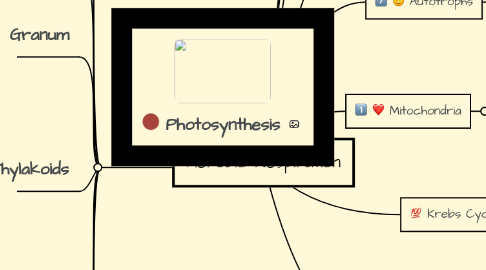Aerobic Respiration
by Mayra Fernandez

1. Photosynthesis
1.1. Chloroplast
1.1.1. A plastid that contains chlorophyll and in which photosynthesis takes place.
1.2. Light reaction cycle
1.2.1. Sunlight
1.2.2. The reaction that occurs as the first phase of photosynthesis, in which energy in the form of light is absorbed and converted to chemical energy in the form of ATP.
1.3. Calvin Cycle
1.3.1. The cycle of enzyme-catalyzed dark reactions of photosynthesis that occurs in the chloroplasts of plants and in many bacteria and that involves the fixation of carbon dioxide and the formation of a 6-carbon sugar.
1.4. Granum
1.4.1. A stacked membranous structure within the chloroplasts of plants and green algae that contains the chlorophyll and is the site of the light reactions of photosynthesis.
1.5. Thylakoids
1.5.1. Each of a number of flattened sacs inside a chloroplast, bounded by pigmented membranes on which the light reactions of photosynthesis take place, and arranged in stacks or grana.
1.5.2. |
1.6. Chlophyll A and B
1.6.1. Its molecule contains a magnesium atom held in a porphyrin ring. This is the meaning of A
1.6.2. A yellow-green chlorophyll pigment which occurs only in plants and green algae. Meaning of B
1.7. Carotenoids
1.7.1. They are terpenoids based on a structure having the formula C40H56.
1.8. Visible and Spectrum
1.8.1. The visible spectrum is the portion of the electromagnetic spectrum that is visible to the human eye.
1.9. Stomata
1.9.1. The gas exchange that occurs when stomata are open facilitates photosynthesis.
2. Krebs Cycle
2.1. This will only occur if there is Oxygen present in the cell.
2.2. Aerobic Respiration has two major stages: The Krebs cycle and the ETC.
3. Glycolysis
3.1. Glycolysis breaks down glucose and forms pyruvate with the production of two molecules of ATP.
3.2. Electron Transport Chain yields 34 ATP.
3.3. The next stage of aerobic respiration is where most of the Energy is derived.
4. Cellular Respiration
4.1. Cellular respiration is the process where cells make ATP by breaking down organic compounds.
4.2. 1st stage: Glycolysis- organic compounds are converted to pyruvic acid, ATP, and NADH.
4.3. Based on if there is oxygen present, the second stage will be either aerobic respiration or fermentation.
5. Fermentation
5.1. If no oxygen is present, Fermentation can´t be broken down.
5.2. The process of fermentation involved in the making of beer, wine, and liquor, in which sugars are converted to ethyl alcohol.
6. Lactic Acid
6.1. Lactic Acid Fermentation is essetial for dairy products. It is important to store these products at temperature or they will ¨spoil.¨
6.2. Lactic Acid Fermentation also occurs in our Muscles.
7. Mitochondria
7.1. The biochemical processes of the cell are known as cellular respiration.
7.2. Mitochondria are known as the powerhouses of the cell.
7.3. Process where sugar is founded in ATP
8. Autotrophs
8.1. An organism that is able to form nutritional organic substances from simple inorganic substances such as carbon dioxide.
9. Hetetrophs
9.1. An organism deriving its nutritional requirements from complex organic substances.
9.2. They consume sugar this is split by Glycolysis,

